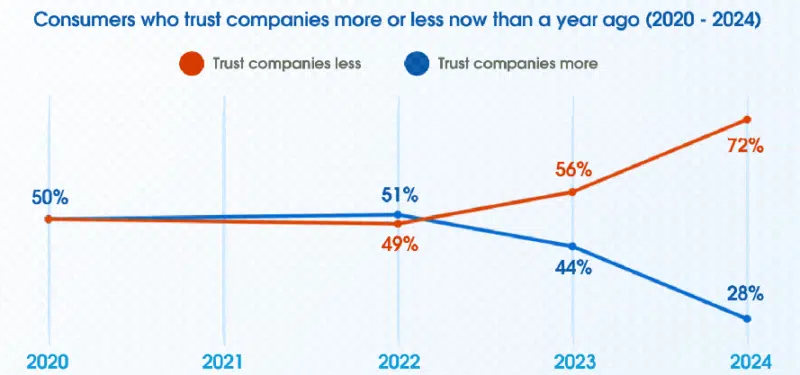How genAI can fill the trust gap for brands
Brands like Saks are using genAI to build trust and improve customer experience transparently.
Brands suffering from a trust deficit might be wary of adding new tools to customer experience. There’s reason to believe genAI, when done right, can build trust — when done transparently.
Sixty percent of customers said because of advances in AI, brands need to improve trustworthiness, according to a new Salesforce survey, “State of the AI Connected Customer.”
The trust gap. Trust is tanking, the Salesforce study found. Close to three-quarters (72%) of consumers said they trust companies less than they did just one year ago.

Bad experiences lead to customers losing trust in brands and leaving. Over a third of customers said bad experiences for purchases, as well as for services like returns, will lead them to look elsewhere. And 69% of consumers said they expect consistent interactions across departments.
Customers assume brands are using a sophisticated data architecture and expect this to translate into better experiences. So they’re disappointed when it doesn’t.
Gen Z. Salesforce found that consumers are favorable toward AI along generational lines. Gen Z is the most receptive, while Boomers and Silent Generation-ers are the most cautious.
- Thirty-four percent of Gen Z consumers said they would share their personal information with an AI agent, 37% are neutral about it.
- Millennials are nearly as receptive — 33% agree; 35% are neutral.
- Thirty-nine percent of Gen X disagree with sharing personal info with an AI agent.
- Fifty-one percent of Boomers disagree and 60% of the Silent Generation also decline.
AI transparency. Over a third of consumers said they would engage with an AI agent to avoid repeating themselves at multiple touchpoints in their experiences. This shows a big upside for introducing an AI-powered agent, but brands must be transparent.
Nearly three-quarters want to know upfront if they’re communicating with AI. And 45% of consumers are more likely to use an AI agent if there’s a clear escalation path or off-ramp that leads to speaking with a human agent, if and when that’s necessary.
“We encourage retailers [when they’re using an AI agent] to clearly call out that this is AI and how to pull the ‘rip cord’ if [customers] need to go and talk to a real person,” said Michael Affronti, SVP & GM, Commerce Cloud at Salesforce.
Why we care. If customers already expect some kind of AI behind the scenes, it’s worth it for brands to address the issue and use AI transparently. Personas are also a great way for brands to welcome the technology to customers. Bank of America’s Erica and the Saks chatbot Sophie are good examples.
Dig deeper: How to use genAI to reduce friction and convert car buyers
Contributing authors are invited to create content for MarTech and are chosen for their expertise and contribution to the martech community. Our contributors work under the oversight of the editorial staff and contributions are checked for quality and relevance to our readers. MarTech is owned by Semrush. Contributor was not asked to make any direct or indirect mentions of Semrush. The opinions they express are their own.
Related stories